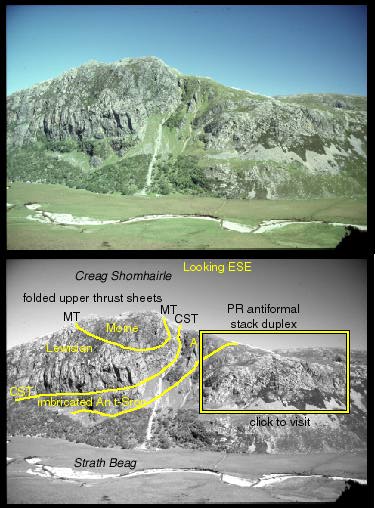
Relationships between thrusts at Creag Shomhairle (NC380505)
The western flank of Creag Shomhairle offers a spectacular natural section, 350m deep, normal to the regional thrusting direction. It is an ideal location to examine lateral variations in thrust structures and is critical for establishing the relative timing of various thrusts (Butler, 1982b). Most of Creag Shomhairle consists of Lewisian gneiss similar to that within the analogous Arnaboll thrust sheet. These gneisses are only weakly affected by deformation associated with thrusting. However, they are structurally overlain by Moine mylonites which now lie preserved in a NW-SE-trending synform that crops out on the summit of Creag Shomhairle. On the vertical, SW limb of the synform, the Lewisian of the Creag Shomhairle sheet tapers out . This fold lies on a plinth of gently dipping Pipe Rock with the two units separated by an imbricated package of Fucoid Beds and Salterella Grit. These imbricates wrap a 100m high dome of thin slices of Pipe Rock that has been stacked up by thrusts. These slices, individually less than 5m thick, become progressively steeper towards the hinterland. This is the classic form of an antiformal stack duplex (Boyer and Elliott, 1982; Butler 1987), a geometry which is indicative of 'piggy-back' thrusting.
The field relationships at Creag Shomhairle are best explained by progressive folding of higher thrust sheets by later-formed, underlying structures (Butler, 1982b). The upper thrusts in a stack were the first to move and the younger thrusts developed deeper and carried the earlier structures on their backs. An additional complication here is that the Lewisian gneisses of the Creag Shomhairle sheet are locally imbricated with the Moine mylonites. These imbricate thrusts generate their own minor folds and crenulation fabrics within the Moine mylonites, indicating that folding in the mylonites correlates with local displacements and shear localisation.
The Creag Shomhairle area is also an excellent site to examine variations in fault-rock types across a thrust array. The transition from crystalline plasticity required for mylonite formation (White, 1982) to cataclasis indicates a decrease in temperature and/or an increase in strain rate. The thrusts on Creag Shomhairle are marked by mylonites at the structurally higher levels but cataclasis is increasingly important on structurally deeper thrusts (Butler, 1982). This apparent conundrum, typical of much of the Moine thrust belt, is explained by the higher thrusts forming first under greater tectonic overburden and that subsequent deeper thrusts formed at shallower levels in the crust. Thus the overall rate of cumulative thickening at the base of the evolving Moine thrust sheet was presumably outpaced by erosion from the top.